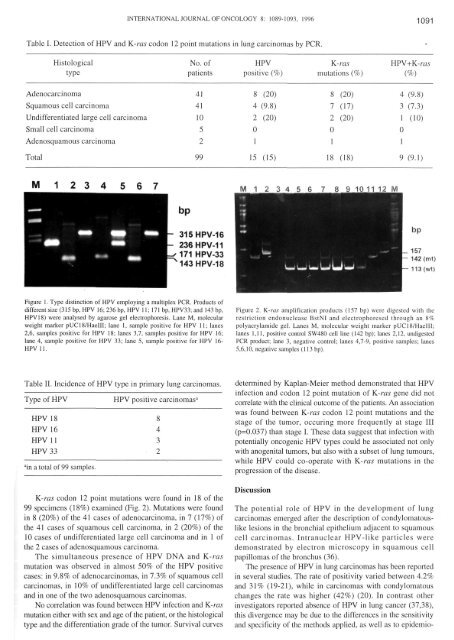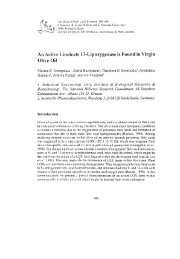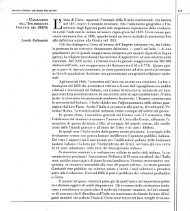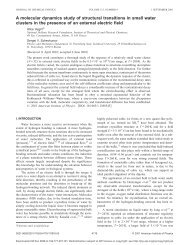Detection of human papilloma virus (HPV) and K-ras mutations in ...
Detection of human papilloma virus (HPV) and K-ras mutations in ...
Detection of human papilloma virus (HPV) and K-ras mutations in ...
Create successful ePaper yourself
Turn your PDF publications into a flip-book with our unique Google optimized e-Paper software.
INTERNATIONAL JOURNAL OF ONCOLOGY 8: 1089-1093, 1996 1091<br />
Table I. <strong>Detection</strong> <strong>of</strong> <strong>HPV</strong> <strong>and</strong> K-<strong>ras</strong> codon 12 po<strong>in</strong>t <strong>mutations</strong> <strong>in</strong> lung carc<strong>in</strong>omas by PCR.<br />
Histological<br />
type<br />
No. <strong>of</strong><br />
patients<br />
<strong>HPV</strong><br />
positive (%)<br />
K-<strong>ras</strong><br />
<strong>mutations</strong> (%)<br />
<strong>HPV</strong>+K-<strong>ras</strong><br />
(%)<br />
Adenocarc<strong>in</strong>oma<br />
41<br />
8 (20)<br />
8 (20)<br />
4 (9.8)<br />
Squamous cell carc<strong>in</strong>oma<br />
Undifferentiated large cell carc<strong>in</strong>oma<br />
Small cell carc<strong>in</strong>oma<br />
Adenosquamous carc<strong>in</strong>oma<br />
41<br />
to<br />
5<br />
2<br />
4 (9.8)<br />
2 (20)<br />
0<br />
1<br />
7 (17)<br />
2 (20)<br />
0<br />
1<br />
3 (7.3)<br />
1 (10)<br />
0<br />
1<br />
Total<br />
99<br />
15 (15)<br />
18 (18)<br />
9 (9.1)<br />
M 1 2 3 4 5 6 7 8 9 10 11 12 M<br />
bp<br />
315<strong>HPV</strong>-16<br />
236<strong>HPV</strong>-11<br />
171 <strong>HPV</strong>-33<br />
143 <strong>HPV</strong>-18<br />
157<br />
142 (mt)<br />
113 (wt)<br />
Figure l. Type dist<strong>in</strong>ction <strong>of</strong> <strong>HPV</strong> employ<strong>in</strong>g a multiplex PCR. Products <strong>of</strong><br />
different size (315 bp, <strong>HPV</strong> 16; 236 bp, <strong>HPV</strong> 11; 171 bp, <strong>HPV</strong>33; <strong>and</strong> 143 bp,<br />
<strong>HPV</strong> 18) were analysed by agarose gel electrophoresis. Lane M, molecular<br />
weight marker pUC18/HaeIII; lane 1, sample positive for <strong>HPV</strong> 11; lanes<br />
2,6, samples positive for <strong>HPV</strong> 18; lanes 3,7, samples positive for <strong>HPV</strong> 16;<br />
lane 4, sample positive for <strong>HPV</strong> 33; lane 5, sample positive for <strong>HPV</strong> 16-<br />
<strong>HPV</strong> 11.<br />
Figure 2. K-<strong>ras</strong> amplification products (157 bp) were digested with the<br />
restriction endonuclease BstNI <strong>and</strong> electrophoresed through an 8%<br />
Polyacrylamide gel. Lanes M, molecular weight marker pUCl8/HaeIII;<br />
lanes 1,11, positive control SW480 cell l<strong>in</strong>e (142 bp); lanes 2,12, undigested<br />
PCR product; lane 3, negative control; lanes 4,7-9, positive samples; lanes<br />
5,6,10, negative samples (113 bp).<br />
Table II. Incidence <strong>of</strong> <strong>HPV</strong> type <strong>in</strong> primary lung carc<strong>in</strong>omas.<br />
Type <strong>of</strong> <strong>HPV</strong><br />
<strong>HPV</strong> 18<br />
<strong>HPV</strong> 16<br />
<strong>HPV</strong> 11<br />
<strong>HPV</strong> 33<br />
a <strong>in</strong> a total <strong>of</strong> 99 samples.<br />
<strong>HPV</strong> positive carc<strong>in</strong>omas"<br />
K-<strong>ras</strong> codon 12 po<strong>in</strong>t <strong>mutations</strong> were found <strong>in</strong> 18 <strong>of</strong> the<br />
99 specimens (18%) exam<strong>in</strong>ed (Fig. 2). Mutations were found<br />
<strong>in</strong> 8 (20%) <strong>of</strong> the 41 cases <strong>of</strong> adenocarc<strong>in</strong>oma, <strong>in</strong> 7 (17%) <strong>of</strong><br />
the 41 cases <strong>of</strong> squamous cell carc<strong>in</strong>oma, <strong>in</strong> 2 (20%) <strong>of</strong> the<br />
10 cases <strong>of</strong> undifferentiated large cell carc<strong>in</strong>oma <strong>and</strong> <strong>in</strong> 1 <strong>of</strong><br />
the 2 cases <strong>of</strong> adenosquamous carc<strong>in</strong>oma.<br />
The simultaneous presence <strong>of</strong> <strong>HPV</strong> DNA <strong>and</strong> K-<strong>ras</strong><br />
mutation was observed <strong>in</strong> almost 50% <strong>of</strong> the <strong>HPV</strong> positive<br />
cases: <strong>in</strong> 9.8% <strong>of</strong> adenocarc<strong>in</strong>omas, <strong>in</strong> 7.3% <strong>of</strong> squamous cell<br />
carc<strong>in</strong>omas, <strong>in</strong> 10% <strong>of</strong> undifferentiated large cell carc<strong>in</strong>omas<br />
<strong>and</strong> <strong>in</strong> one <strong>of</strong> the two adenosquamous carc<strong>in</strong>omas.<br />
No correlation was found between <strong>HPV</strong> <strong>in</strong>fection <strong>and</strong> K-<strong>ras</strong><br />
mutation either with sex <strong>and</strong> age <strong>of</strong> the patient, or the histological<br />
type <strong>and</strong> the differentiation grade <strong>of</strong> the tumor. Survival curves<br />
4<br />
3<br />
2<br />
determ<strong>in</strong>ed by Kaplan-Meier method demonstrated that <strong>HPV</strong><br />
<strong>in</strong>fection <strong>and</strong> codon 12 po<strong>in</strong>t mutation <strong>of</strong> K-<strong>ras</strong> gene did not<br />
correlate with the cl<strong>in</strong>ical outcome <strong>of</strong> the patients. An association<br />
was found between K-<strong>ras</strong> codon 12 po<strong>in</strong>t <strong>mutations</strong> <strong>and</strong> the<br />
stage <strong>of</strong> the tumor, occur<strong>in</strong>g more frequently at stage III<br />
(p=0.037) than stage I. These data suggest that <strong>in</strong>fection with<br />
potentially oncogenic <strong>HPV</strong> types could be associated not only<br />
with anogenital tumors, but also with a subset <strong>of</strong> lung tumours,<br />
while <strong>HPV</strong> could co-operate with K-<strong>ras</strong> <strong>mutations</strong> <strong>in</strong> the<br />
progression <strong>of</strong> the disease.<br />
Discussion<br />
The potential role <strong>of</strong> <strong>HPV</strong> <strong>in</strong> the development <strong>of</strong> lung<br />
carc<strong>in</strong>omas emerged after the description <strong>of</strong> condylomatouslike<br />
lesions <strong>in</strong> the bronchial epithelium adjacent to squamous<br />
cell carc<strong>in</strong>omas. Intranuclear <strong>HPV</strong>-like particles were<br />
demonstrated by electron microscopy <strong>in</strong> squamous cell<br />
<strong>papilloma</strong>s <strong>of</strong> the bronchus (36).<br />
The presence <strong>of</strong> <strong>HPV</strong> <strong>in</strong> lung carc<strong>in</strong>omas has been reported<br />
<strong>in</strong> several studies. The rate <strong>of</strong> positivity varied between 4.2%<br />
<strong>and</strong> 31% (19-21), while <strong>in</strong> carc<strong>in</strong>omas with condylomatous<br />
changes the rate was higher (42%) (20). In cont<strong>ras</strong>t other<br />
<strong>in</strong>vestigators reported absence <strong>of</strong> <strong>HPV</strong> <strong>in</strong> lung cancer (37,38),<br />
this divergence may be due to the differences <strong>in</strong> the sensitivity<br />
<strong>and</strong> specificity <strong>of</strong> the methods applied, as well as to epidemio-
















